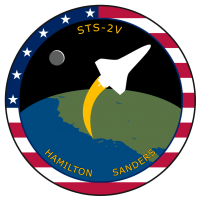Difference between revisions of "STS-2V"
Lafayette1 (talk | contribs) m |
Lafayette1 (talk | contribs) (→Crew) |
||
| (9 intermediate revisions by the same user not shown) | |||
| Line 1: | Line 1: | ||
{{Infobox Space mission | {{Infobox Space mission | ||
| mission_name = STS-2V | | mission_name = STS-2V | ||
| − | | insignia = | + | | insignia = 2V.png |
| shuttle = Terra Nova | | shuttle = Terra Nova | ||
| crew_members = 2 | | crew_members = 2 | ||
| Line 15: | Line 15: | ||
| crew_photo = | | crew_photo = | ||
| crew_caption = | | crew_caption = | ||
| − | | previous = [[STS-92-A|STS-1V/92-A]] [[Image:Shuttle Patch.svg |35px|STS-92-A]] | + | | previous = [[STS-92-A|STS-1V/92-A]] [[Image:Shuttle Patch.svg|35px|STS-92-A]] |
| − | | next = [[STS-3V]] [[Image:Shuttle Patch.svg |35px|STS-3V]] | + | | next = [[STS-3V]] [[Image:Shuttle Patch.svg|35px|STS-3V]] |
}} | }} | ||
| − | '''STS-2V''' was the first flight of the [[Space Shuttle Terra Nova|Space Shuttle ''Terra Nova'']], launched on March 4 2009, and returning to Earth on March 6. ''Terra Nova'' orbited the earth 42 times in this 63 and a half hour mission. It was the first manned polar orbit mission, and the first West Coast Space Shuttle launch. | + | '''STS-2V''' was the first flight of the [[Space Shuttle Terra Nova|Space Shuttle ''Terra Nova'']], launched on March 4 2009, and returning to Earth on March 6. ''Terra Nova'' orbited the earth 42 times in this 63 and a half hour mission. It was the first manned polar orbit mission, and the first successful West Coast Space Shuttle launch. |
==Crew== | ==Crew== | ||
| Line 27: | Line 27: | ||
|position1 = Commander | |position1 = Commander | ||
|crew1_up = Harold Hamilton | |crew1_up = Harold Hamilton | ||
| − | |flights1_up = | + | |flights1_up = Third |
|position2 = Pilot | |position2 = Pilot | ||
|crew2_up = David Sanders | |crew2_up = David Sanders | ||
| − | |flights2_up = | + | |flights2_up = Third |
}} | }} | ||
| Line 58: | Line 58: | ||
==Mission contingency preparations== | ==Mission contingency preparations== | ||
| − | Due to the launch failure of | + | Due to the launch failure of ''Endeavour'' on [[STS-92-A|STS-1V]], contingency plans were fully prepared prior to the mission. In preparation for a possible [[TAL]] at Mataveri Airport, all necessary equipment was flown in by the United States Air Force in cooperation with the government of Chile. Additional facilities on Easter Island were built, including satellite tracking and relay stations, advanced weather radar and newly updated airport terminals and ground support services. The [[Wikipedia:Shuttle Carrier Aircraft|Shuttle Carrier Aircraft]] was heavily modified prior to liftoff in order to extend its range and provide the ability for mid-air refueling. For this mission, the designated [[TALCOM]] was Michael Hill, a veteran astronaut at the [[International Space Agency|ISA]]. |
==External links== | ==External links== | ||
Latest revision as of 18:46, 4 October 2016
| STS-2V | |||||
Mission insignia | |||||
| Mission statistics | |||||
|---|---|---|---|---|---|
| Mission name | STS-2V | ||||
| Space shuttle | Terra Nova | ||||
| Crew size | 2 | ||||
| Launch pad | SLC-6 | ||||
| Launch date | March 4, 2009, 18:30:15 UTC | ||||
| Landing | March 7, 2009, 06:55:15 UTC | ||||
| Mission duration | 2 days, 15 hours, 25 minutes | ||||
| Number of orbits | 42 | ||||
| Orbital period | 90 minutes | ||||
| Orbital altitude | 191 miles (307 km) | ||||
| Orbital inclination | 90° | ||||
| Distance traveled | 1.1 million miles (1.8 million km) | ||||
| Related missions | |||||
| |||||
STS-2V was the first flight of the Space Shuttle Terra Nova, launched on March 4 2009, and returning to Earth on March 6. Terra Nova orbited the earth 42 times in this 63 and a half hour mission. It was the first manned polar orbit mission, and the first successful West Coast Space Shuttle launch.
Contents
Crew
| Position | Astronaut | |
|---|---|---|
| Commander | Harold Hamilton Third spaceflight | |
| Pilot | David Sanders Third spaceflight | |
Backup crew
| Position | Astronaut | |
|---|---|---|
| Commander | Boston Low | |
| Pilot | Ken Borden | |
Mission parameters
- Mass:
- Orbiter Liftoff: 219,396 lb (99,453 kg)
- Orbiter Landing: 195,606 lb (88,662 kg)
- DFI payload: 10,822 lb (4,909 kg)
- Perigee: 168 mi (270 km)
- Apogee: 177 mi (285 km)
- Inclination: 90°
- Period: 90 minutes
Mission highlights
Mission contingency preparations
Due to the launch failure of Endeavour on STS-1V, contingency plans were fully prepared prior to the mission. In preparation for a possible TAL at Mataveri Airport, all necessary equipment was flown in by the United States Air Force in cooperation with the government of Chile. Additional facilities on Easter Island were built, including satellite tracking and relay stations, advanced weather radar and newly updated airport terminals and ground support services. The Shuttle Carrier Aircraft was heavily modified prior to liftoff in order to extend its range and provide the ability for mid-air refueling. For this mission, the designated TALCOM was Michael Hill, a veteran astronaut at the ISA.
External links
| ||||||||
| ||||||||||||||||||||||||||